Soaring into the board game world is Wingspan, a card collecting, engine-building game from designer Elizabeth Hargrave and Stonemaier Games. With 170 beautifully illustrated hand-painted bird cards in the base game, you’ll explore the diversity of birds in North America. Current and future expansions cover other continents. All birds have unique abilities and characteristics, food/habitat preferences, and nest/egg behavior. Attract birds to your nature preserve, feed them, lay eggs, and meet bonus/round goals to score points and win the game!
Award-winning Game Accessible to Gamers of all levels
Wingspan ranks as #1 Family Game and #23 Overall on BGG. The game has won numerous awards, including the 2019 Kennerspiel des Jahres for best connoisseur game of the year. Both beginner and hardcore gamers can enjoy the gameplay. With only four actions to take on your turn, Wingspan is accessible to new players. In addition, from the 7th printing on, the base game box includes Wingspan: Swift-Start Promo Pack, which includes ten new bird cards and four player guides on playing the first four rounds. This helpful beginner’s boost gives newcomers a feel for building their engines for their first plays. This Swift-Start Pack is also available separately, which I purchased.
How to Play – Multiplayer
Up to 5 players can play Wingspan competively. This week I’ve been mostly playing the game solo against the Automa, which includes its deck of cards. Below is the setup for a solo game. For a multiplayer game, you’d see additional player mats and no Automa cards.
Setting up Wingspan
Shuffle the bird cards, place them facedown in a deck, then place three face-up bird cards next to the bird deck. Next, shuffle the bonus cards in a facedown bonus deck. Place all eggs and food tokens nearby. Toss the food dice in the bird feeder for five starting food choices.
Choose your goal board side: Green (default) is direct competition with 1st place, 2nd place and so on, and Blue is less competitive; players score for each targeted item. Shuffle the goal tiles and place them randomly on each of the four blank spaces on the goal board. The photo below has the Green Competitive side with the four goals in place. In order, the goals for this game are:
- Forest Habitat birds
- Grasslands Habitat birds
- Eggs in Cup Nests
- Sets of Eggs in each habitat
The later rounds score more points, so think ahead to score the big points!
Player Setup
Give each player a player mat, eight action cubes of one color, five bird cards, five food tokens (one of each food type) and 2 Bonus cards. Out of these ten cards/food, choose 5 to keep. For example, you’ll end up with 3 Birds and 2 Food, or 1 Bird and 4 Food. In other words, for each bird card you keep, you must discard one food token. Finally, choose one bonus card and discard the other.
Make sure you check the Round goals and your personal Bonus goal to help you decide which birds to keep. Also, take a close look at the Bird abilities in your starting hand and the three available birds in the Draw area to figure out what food you’ll need or what cards you want to play first.
Gameplay
The game plays in four Rounds. During each round, players take turns until each player has used all of their available action cubes.
In Round 1, you’ll have all eight action cubes. After each round, place one action cube on the goal board. Therefore, each round has one less action to play; Round 2 players have seven actions, Round 3 6 actions and Round 4 only five action cubes.
Turn Structure
On your turn, take one of 4 actions, as shown on the left side of your player mat.
Examining this playmat, you’ll also notice three distinct habitats. From the top is the green forest, where you’ll be able to gain food. In the middle is the grasslands habitat, where you can lay eggs, and on the bottom of the mat is the wetlands, which enables you to draw more bird cards. You’ll be filling this mat from left to right with bird cards.
Gain Food, Lay Eggs and Draw Cards have the following three steps:
- Choose a habitat on your mat and place your action cube on the leftmost empty slot in the row. Gain the benefit of that slot – gain food, lay eggs or draw cards.
- Move your action cube right to left to the next slot in the row, activating any birds on that slot with the brown “WHEN ACTIVATED” power in that row (power is optional).
- When your action cube reaches the far left column, your turn is over.
The Four Wingspan Actions
Play a Bird
In Wingspan is all about the birds! Make sure you play the right birds to score the most points and use their abilities to build a good engine—place birds in one of three habitats. Choose either the forest, grassland, or wetland. Some birds can be placed in all three and fly to a different habitat during your action! The more birds you place in a habitat, the better the habitat rewards.
When you place a bird, choose the habitat, and place your action cube (or, in my case, a bird token) on the leftmost exposed slot in that row. Next, you must pay its food cost. It will be a combination of an invertebrate (green worm), fruit (red berry), seed (yellow grain), fish (blue), rodent (gray mouse) or wild, any food (depicted by the pie chart icon with all five colors). The first column of each habitat requires no egg cost; the other columns cost one or two eggs to play the bird. The first column requires no eggs as payment for birds. As you can see below, I chose to play a bird in the forest habitat, so I paid the invertebrate food, and since it was in the first column, there was no egg cost. I then placed the card.
This Hummingbird could go into any habitat. There are two reasons I chose the Forest habitat. Placing birds in the Forest habitat is the first goal, and I wanted to start my food engine.
Gain Food
Birds need to eat, and all have their preferred foods. When you place your action cube in the Gain Food/Forest row, you take that action, gaining 1-3 food tokens available in the bird feeder. You’ll have to choose from the five available food dice as shown face up in the feeder. If there is ever only one type of food icon shown, you can re-roll all five dice and choose your food. Seeds and Invertebrates are the most common food birds eat in the game, so a sixth side of the die allows you to choose either seed or invertebrate.
Once you choose your food, remove that die from the feeder, take the corresponding food token from the resources, and place it in your area. Many birds placed in the Forest habitat allow you to gain food. So as you move to the left, you take any Brown Actions on the bird cards until you reach the leftmost slot.
Lay Eggs
Feather your nest by laying eggs will help you place more birds and score goals. But don’t put all of your eggs in one basket! Make sure you place them where you’ll score goal points; starred nests are especially advantageous, as they count for any nest depicted in goals.
Again, place your action token in the leftmost empty slot in the Lay Eggs row and take that amount of eggs and place them on any of your birds. In some spaces, you’ll have the option to lay an additional egg if you spend a food. You are then going from right to left, most your action token to each bird, activating its Brown Power until you reach the furthermost left column.
Don’t these eggs look delicious? It’s like easter candy!
Draw a Card
A bird in hand is worth two in the bush. Or rather, in Wingspan, a bird in hand is worth nothing but worth everything in the bush. The Wetlands habitat allows you to draw cards. You can choose from the three faceup bird cards or draw from the facedown deck. You know the drill, draw the cards you’re allowed; in some slots, you may pay an optional egg for an additional card. Then go from right to left, activating the brown powers. As you can see below, the Forster’s Tern that lives only in the Wetlands habitat allows you to draw an extra card as its Brown ability and then discard any card from your hand at the end of your turn.
Perfect your Bird Engine!
One of the things I love about Wingspan is that the bird actions simulate real-life bird species’ abilities. Try to line up your birds in each row to capitalize on their Brown “When Activated” abilities which you can utilize each time you take that row’s action. Don’t forget Pink “Once Between Turns” Abilities which can trigger for you on other players’ turns. Also, the “Play Once” ability is the only ability you can play when you Play a bird, and it is only done once during a game.
For example, this Bronzed Cowbird lays its own eggs in other birds’ nests. The Pink ability is to lay one egg in another bird with a Cup nest, like the two birds above it.
Some birds like to store food for later. You can “cache” food icons on the card. Other noteworthy actions are “tucking” a card underneath the bird card – indicating perhaps a flocking preference or eating a smaller bird as prey. Both of these actions – tucking cards and caching food score you one point each. Make sure to take into account these additional score-gaining methods in your engine.
End of Game
Once everyone has placed all their available action cubes, it’s time to score for the game! The player with the most points wins! Use the included scorepad and add points for the following:
- Each bird card (printed on the card as number of feathers)
- Each bonus card scored
- End of round goals
- 1 point each for:
- Eggs on bird cards
- Food tokens cached on bird cards
- Cards tucked under bird cards
Though this particular bonus card is hard to score for, I love the reference to another Stonemaier game – Viticulture!
Wingspan Solo Play
First, make sure you’re familiar with the competitive 2+ player gameplay. The Solo game plays similarly but uses an Automa as your opponent. You take your turn first, playing as usual.
After your turn, the Automa takes a turn. First, draw an Automa card, set it on the Automa round card and take the action. The two Automa Action cards describe its actions. They are pretty self-explanatory, and you’ll have them memorized in no time.
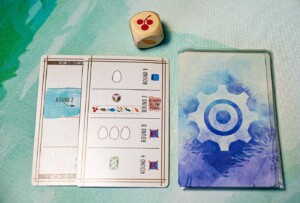
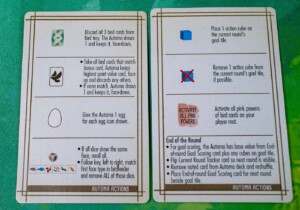
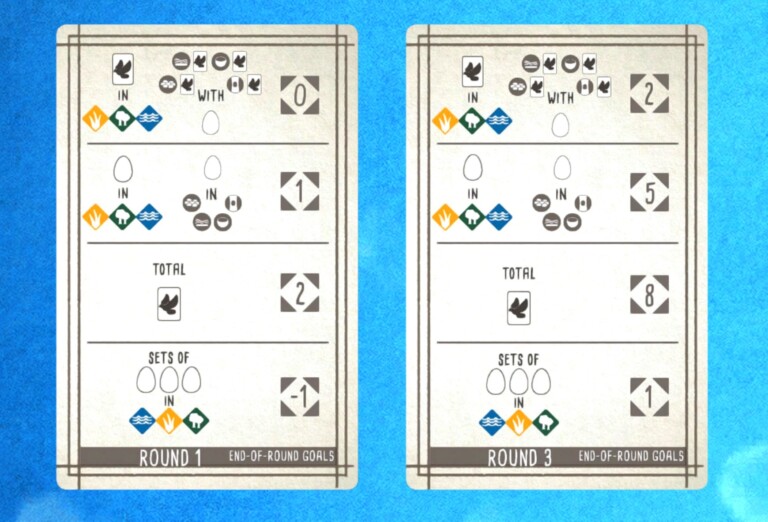
Wingspan Automa – Round scores
Examining the images above (click to see larger), on Round Two, the Automa takes a Food Die from the Bird Feeder. In this case, the first food icon is a berry, and since there’s a berry in the feeder, it removes that die from the feeder. If there were not a berry, it would take the next food item and remove all those dice from the feeder. Lastly, it triggers All Pink Actions, which you can do at this time.
End of game Goals against Wingspan Automa
It’s hard to beat the Automa, but at least try to meet the goal requirement once, so you score some points. You’ll gain zero round points for that round if you don’t.
Below is my end-game layout for a solo game. I have been playing on Easy mode where the Automa gains 3 points per bird card.
Wingspan Summary and Review
I’m so impressed with the accessibility of Wingspan. It took a theme appealing to a new member base, including women and lured more gamers into the board game world. The Swift-Start pack was an ingenious idea as well.
Gameplay is puzzly yet relaxing. The components are some of the best I’ve seen. The colorful bird cards, pastel eggs and even the included cardboard birdfeeder are above and beyond what most games offer. You can also play Wingspan on an app, Steam and Tabletopia. The app and Steam versions are extremely well done!
It was pointed out to me on Reddit that I have all this extra bling that I’ve accumulated for a game I only played this week. But I am a bird enthusiast and knew I’d love this game, and I do! Plus, now I appreciate birds even more!
I found this helpful link if you want to take a closer look at the birds; unfortunately, they only outline the birds: https://navarog.github.io/wingsearch/ You’ll have to purchase Wingspan to see the beautiful artwork!
In conclusion, Wingspan is something to crow about and a worthy addition to anyone’s game collection!
Array
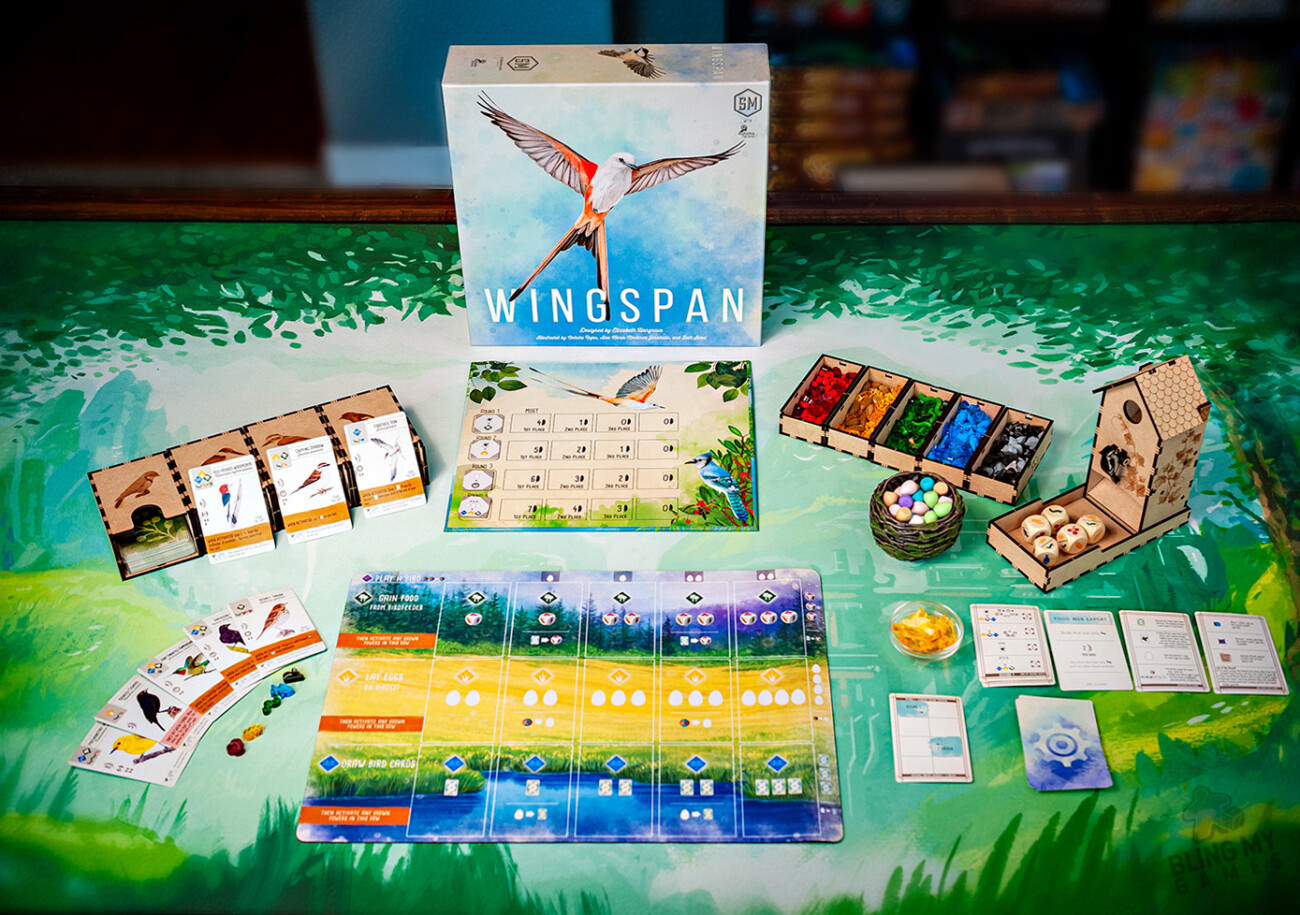
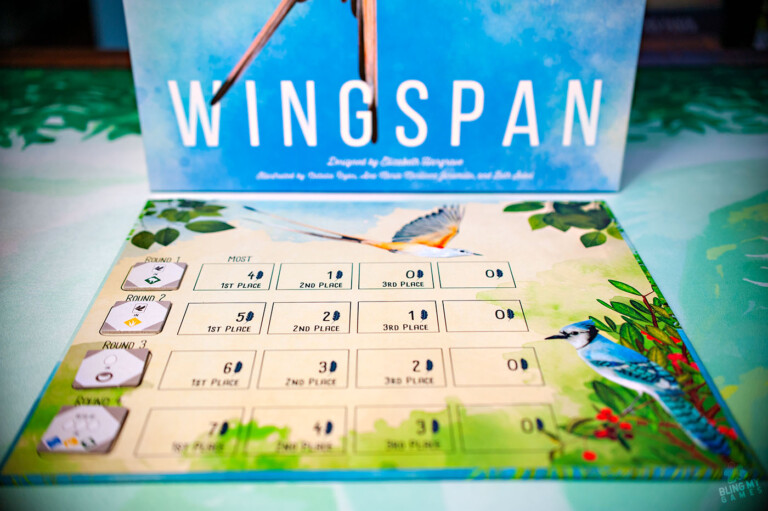
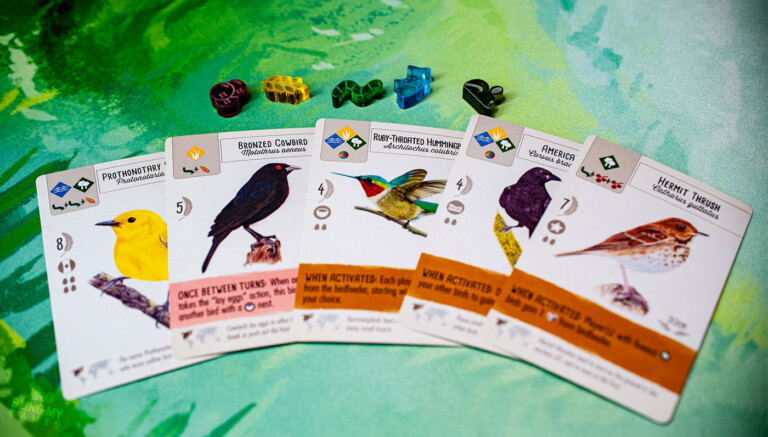

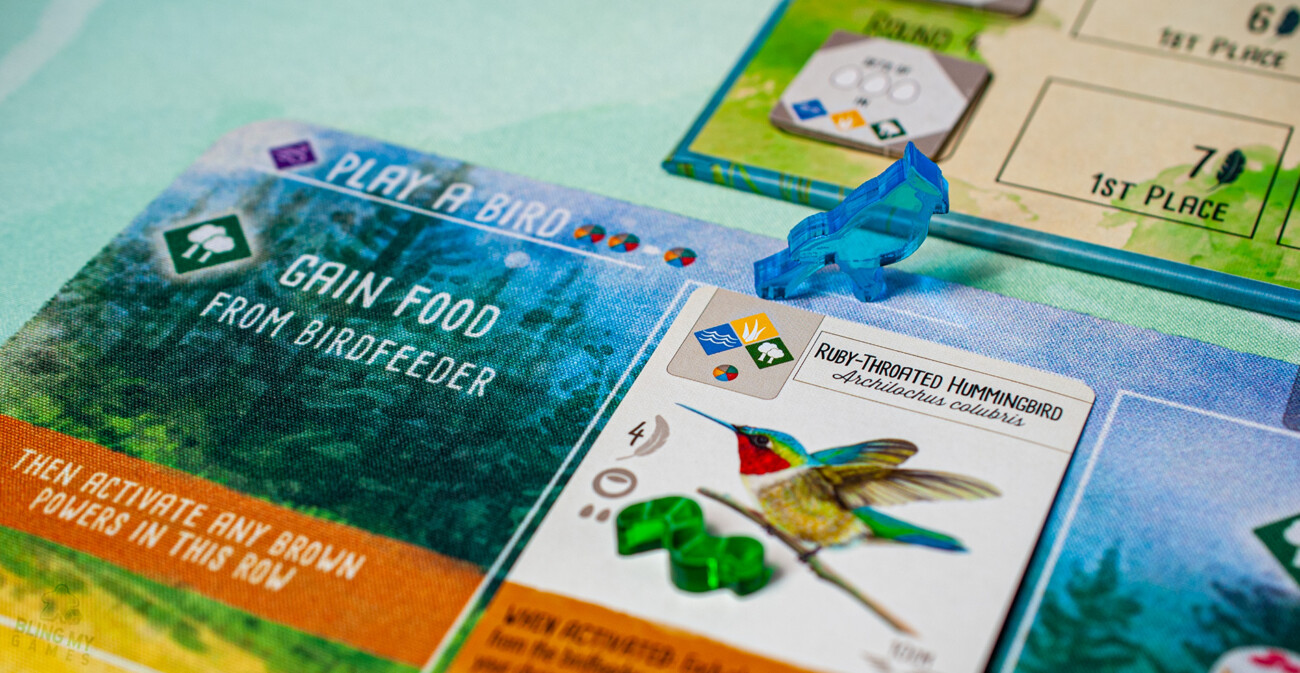
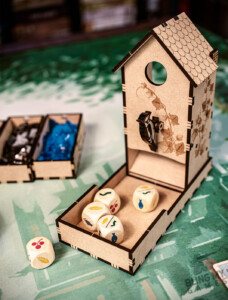
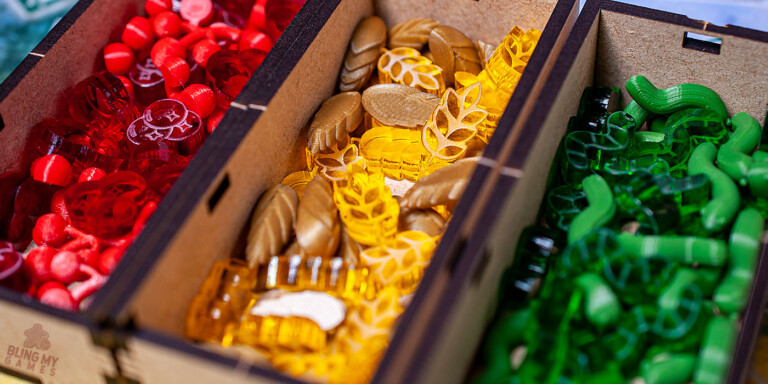
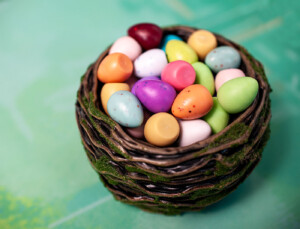
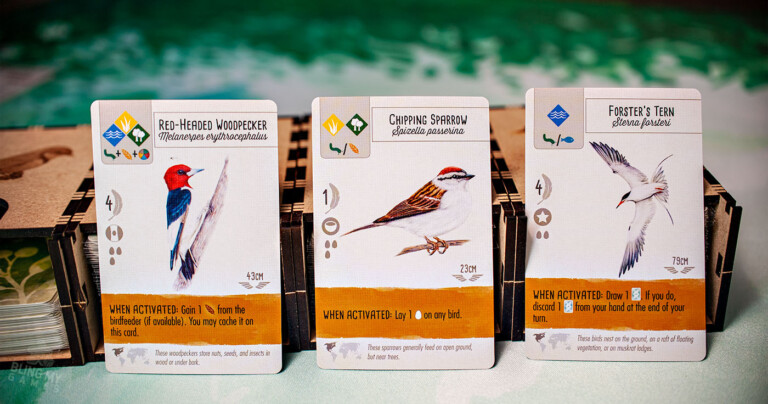
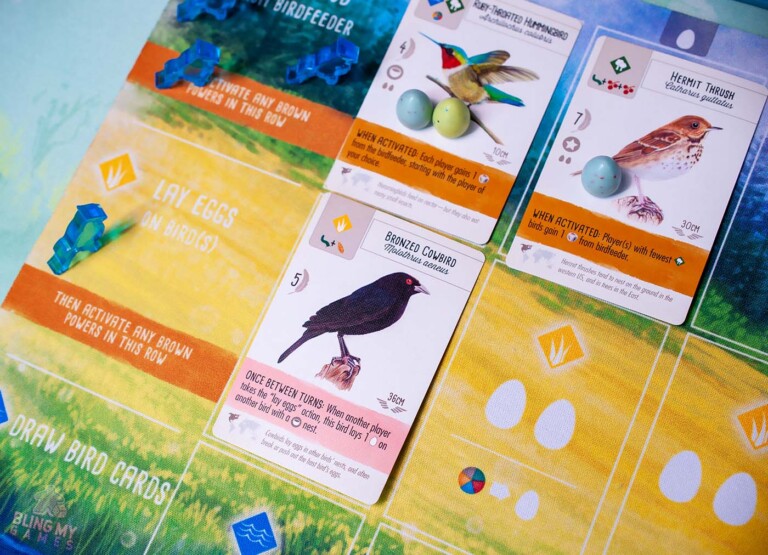
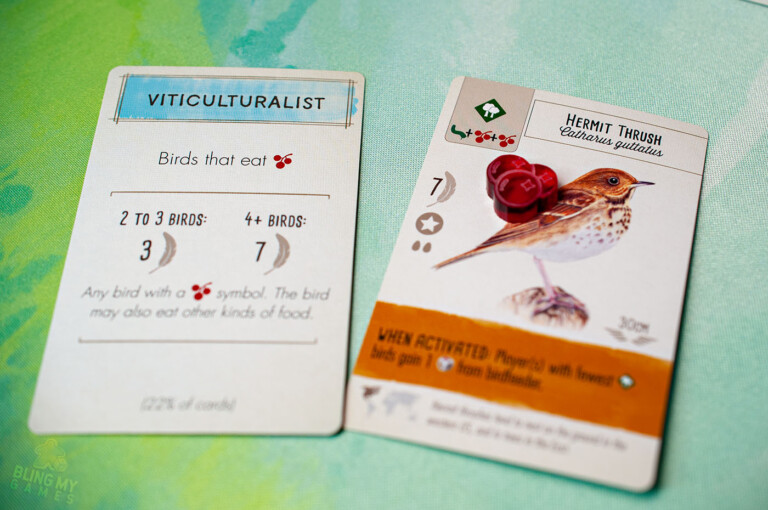
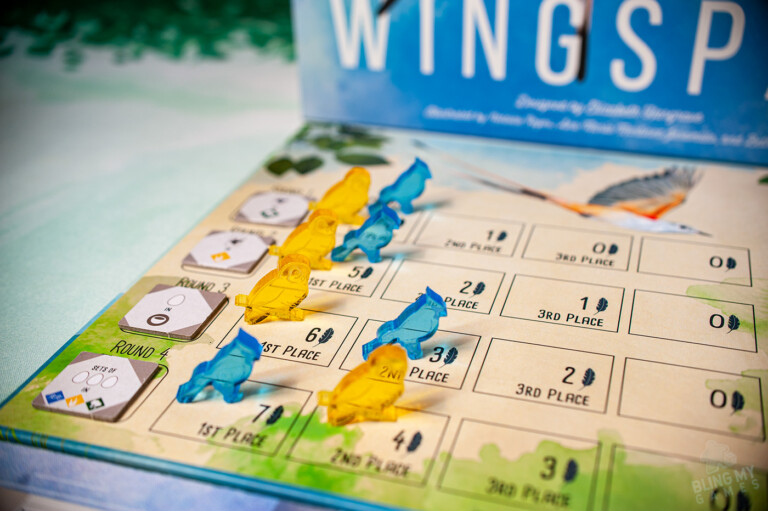
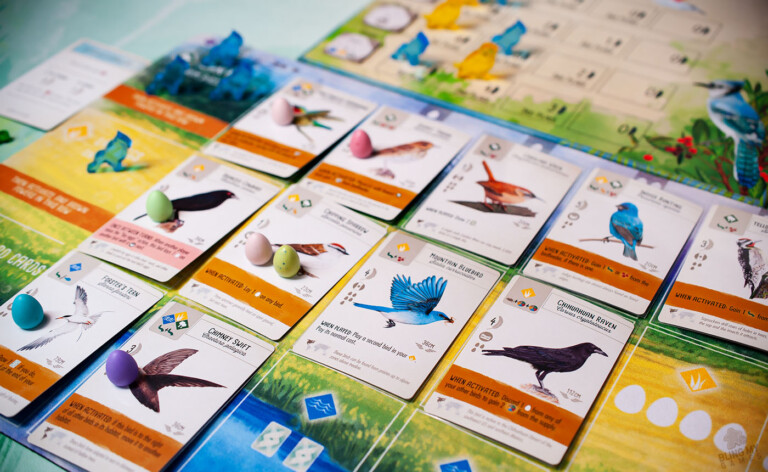
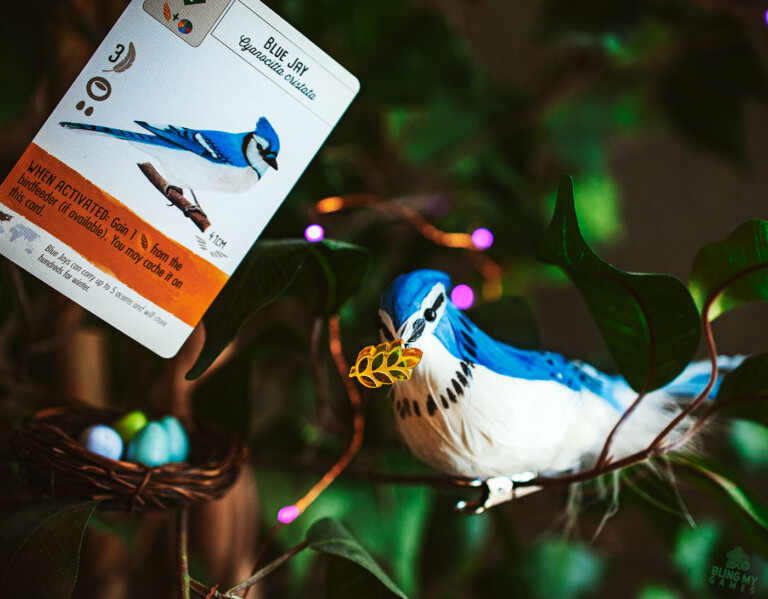
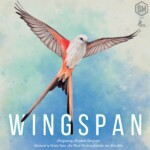 Wingspan
Wingspan